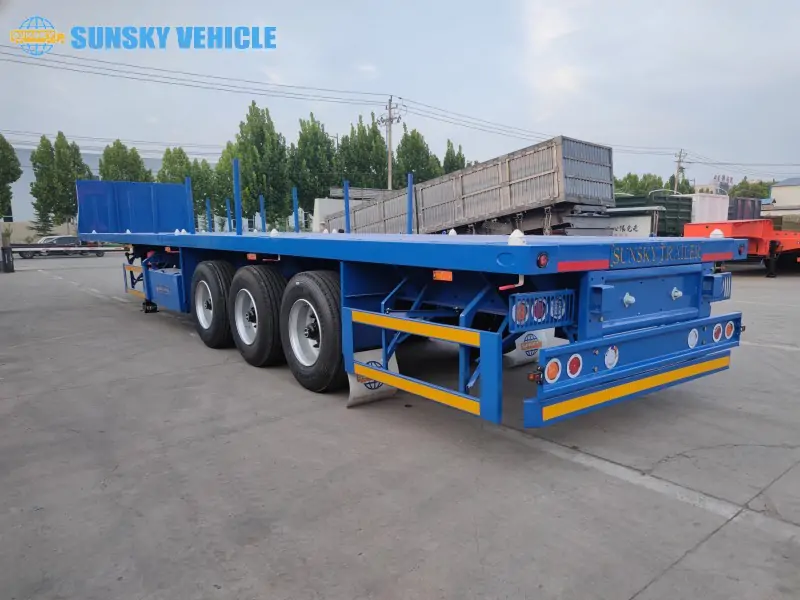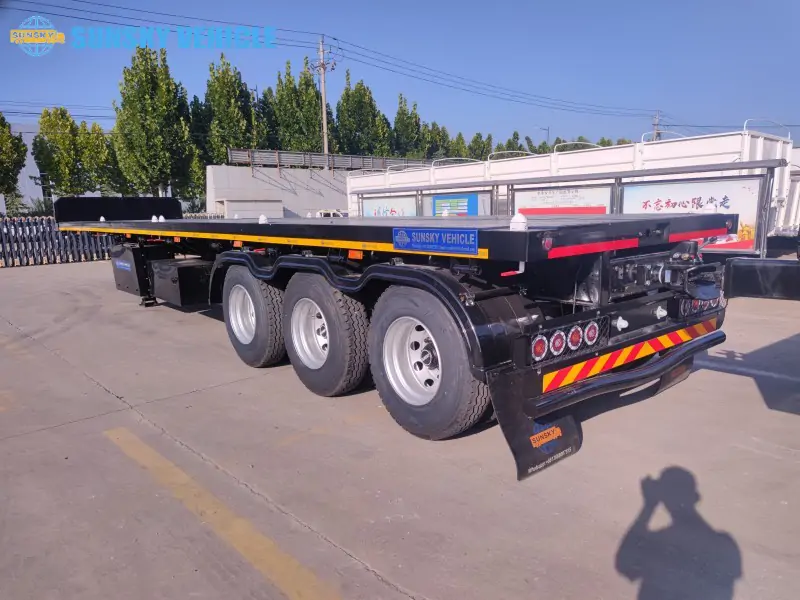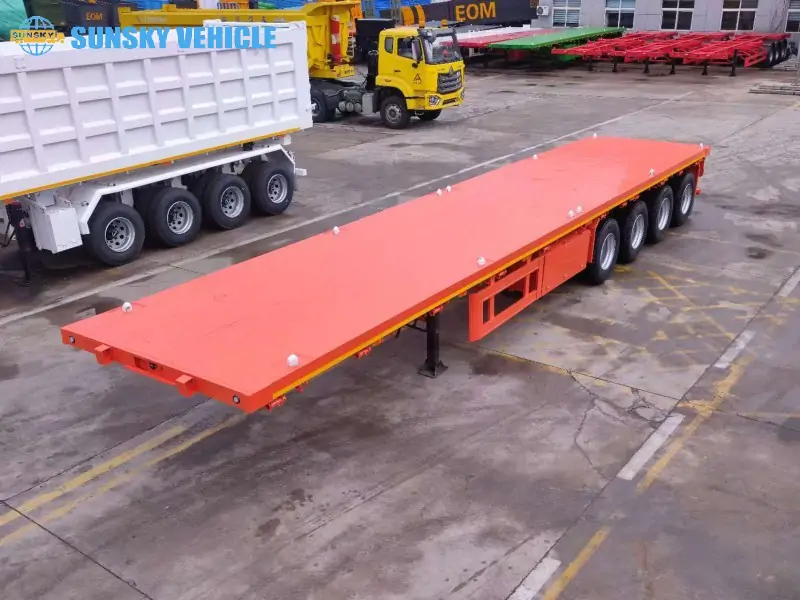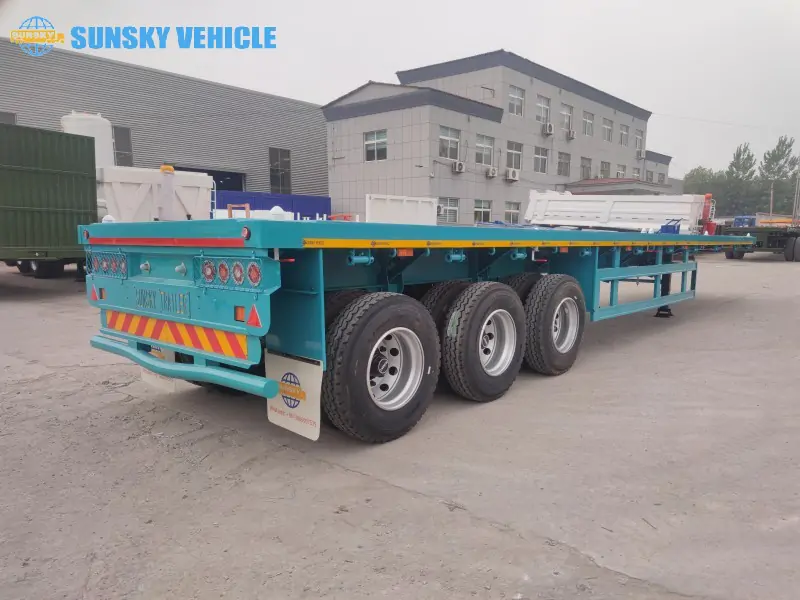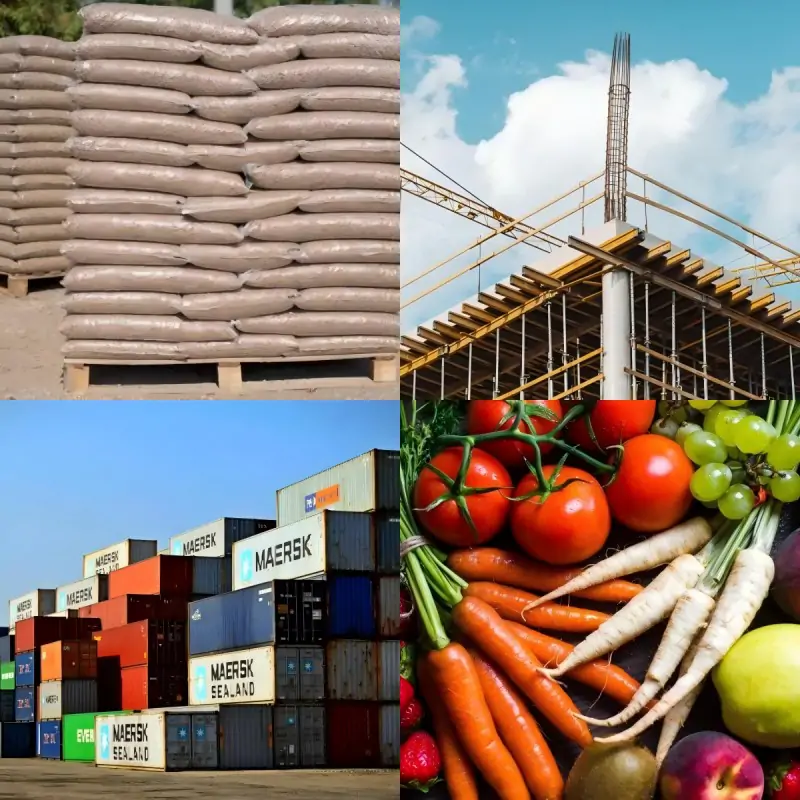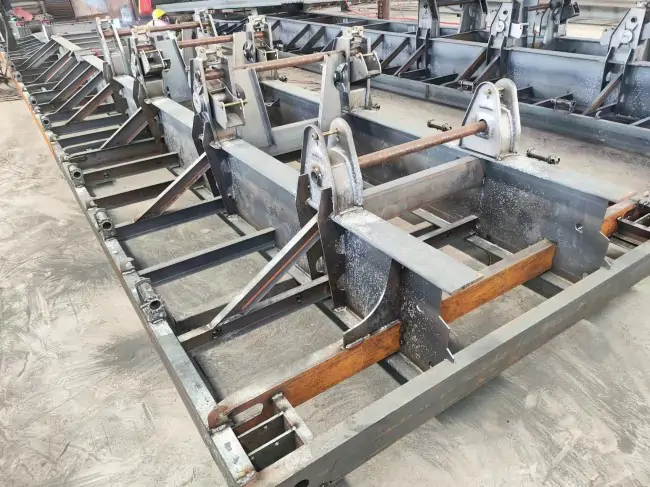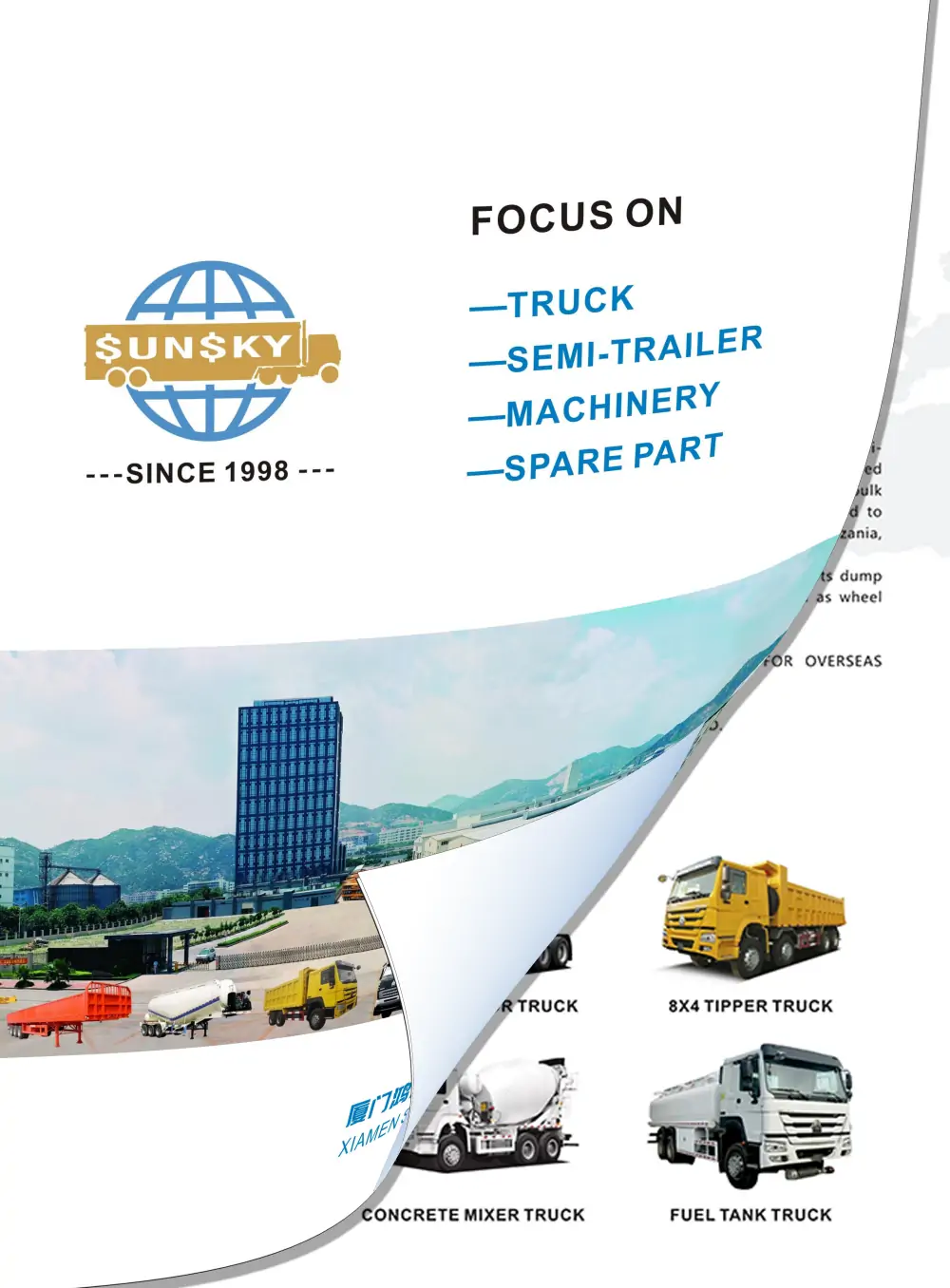Introduction
In today’s fast-growing logistics and construction industries, transport flexibility and efficiency have become key to success. Companies across global freight, construction, and agriculture sectors increasingly rely on multi-purpose trailers to move large, irregular, or heavy cargo safely and efficiently.
Among these trailer types, the flat deck trailer—also known as a flatbed trailer—has emerged as one of the most versatile solutions in modern transport.
But what exactly is a flat deck trailer, and why is it so popular in industries such as construction, logistics, and heavy equipment transport?
This article provides a complete, easy-to-understand guide to flat deck trailers—covering their structure, functions, major use cases, benefits, safety regulations, and how to choose the right model for your business needs.
By the end, you’ll have a clear understanding of how flat deck trailers work, why they’re indispensable in heavy-duty logistics, and how they compare to other trailer types.
Definition: What Is a Flat Deck Trailer?
A flat deck trailer, also known as a flatbed trailer, is a type of open-platform transport vehicle designed for carrying large, irregularly shaped, or oversized cargo that cannot fit inside enclosed trailers.
Unlike box or curtain-sided trailers, a flat deck trailer has no sides or roof, offering maximum flexibility for loading and unloading from any direction — side, top, or rear. This makes it ideal for carrying construction materials, heavy machinery, steel structures, lumber, and agricultural equipment.
Core Structure
A standard flat deck trailer is built with several key components:
-
Main beam / chassis – provides the trailer’s primary strength and load-bearing capacity.
-
Deck surface – the flat loading area, typically made from steel, aluminum, or treated hardwood.
-
Axles and suspension system – ensure stability and support heavy loads evenly.
-
Brake and lighting system – designed for highway compliance and safety.
-
Coupling system – connects the trailer securely to the tractor or truck via a fifth wheel or drawbar setup.
Relationship with Flatbed Trailers
In most global markets, “flat deck trailer” and “flatbed trailer” are interchangeable terms.
However, some regions use “flat deck” specifically to refer to trailers with a completely flat loading surface, while “flatbed” may include step decks or low-profile variants.
Common Sizes and Capacity
Flat deck trailers come in various configurations:
-
Length: typically 20 ft, 40 ft, 45 ft, or 53 ft
-
Width: usually 8.5 ft (2.6 m)
-
Load capacity: ranges from 10 to 60 tons, depending on the number of axles and material strength.
Common Design Variants
-
Fixed flat deck: standard non-extendable platform for general freight.
-
Extendable / telescopic deck: adjustable length for transporting long cargo such as beams or wind turbine blades.
-
Ramp-equipped deck: includes loading ramps for vehicles or machinery.
Key Components & Structure Overview
A flat deck trailer is built for strength, stability, and versatility. Every component is engineered to handle heavy-duty loads while ensuring safety and compliance with international transport standards. Below is a breakdown of its major structural parts and their key functions.
1. Deck Platform
The deck platform is the trailer’s working surface — a flat, open area used for loading cargo of various shapes and sizes.
-
Materials: Typically made from high-tensile steel, aluminum, or treated hardwood.
-
Surface Design: Many trailers feature anti-slip tread plates or durable wooden flooring to prevent cargo slippage during transit.
-
Reinforcement: Cross members and side rails provide additional strength and rigidity to support high loads evenly.
2. Axle & Suspension System
The axle configuration and suspension system determine a flat deck trailer’s load-bearing capacity and road performance.
-
Axles: Usually 2–4 axles, depending on the trailer’s total capacity and regional regulations.
-
Suspension Types:
-
Mechanical (leaf spring) – durable and cost-effective for heavy-duty conditions.
-
Air suspension – offers smoother rides and better protection for fragile cargo.
-
-
Proper axle alignment improves stability, tire life, and braking performance.
3. Coupling System
Flat deck trailers typically use a kingpin + fifth wheel coupling system to connect to the tractor unit.
-
Kingpin: Mounted at the front underside of the trailer.
-
Fifth Wheel: Installed on the truck, locking securely onto the kingpin.
This system allows easy detachment, safe load transfer, and smooth articulation when turning.
4. Load Securing Equipment
To ensure cargo safety, flat deck trailers are equipped with multiple load-securing accessories, such as:
-
Load straps & chains – for tying down heavy machinery or irregular cargo.
-
D-rings & anchor points – built into the deck for flexible cargo positioning.
-
Edge protectors & tarps – prevent damage to both cargo and trailer during long-distance hauls.
Pro Tip: Proper load securing is not just about stability — it’s also a legal requirement in most countries.
5. Lighting & Braking Systems
Safety and compliance are top priorities in trailer design.
-
Lighting: Includes rear, side, and clearance lights, all compliant with DOT / ECE regulations.
-
Braking System: Air brakes are standard, featuring ABS or EBS (electronic braking systems) for modern models.
-
Reflective markings improve visibility during night operations or adverse weather.
How Does a Flat Deck Trailer Work?
A flat deck trailer operates on a simple yet highly efficient principle — it provides an open, stable, and easily accessible platform for loading and transporting all kinds of goods, from industrial machinery to building materials. Its versatility lies in how it can be loaded, secured, and transported safely under various conditions.
1. Loading Principle
Unlike enclosed trailers, a flat deck trailer has no walls or roof, allowing cargo to be loaded and unloaded from any direction — top, side, or rear.
-
This open design is ideal for oversized or irregularly shaped cargo that cannot fit into box trailers.
-
Forklifts, cranes, or hydraulic ramps can easily place materials or machinery onto the deck.
-
Some trailers feature extendable decks or removable ramps to simplify handling of long or heavy equipment.
2. Power and Load Distribution
A flat deck trailer itself has no engine — it relies on the tractor unit (truck head) for pulling power.
-
The load-bearing capacity is distributed across multiple axles and suspension systems, ensuring stability even under high weight.
-
Proper weight distribution is crucial to avoid excessive stress on any single axle and to maintain balanced braking performance.
-
Most models are engineered with reinforced beams to handle loads between 10 to 60 tons, depending on design and regional limits.
3. Balance and Safety Control
Cargo safety is a major operational priority. Because the deck is open, ensuring that the load stays stable is critical.
-
Operators use chains, straps, D-rings, and anchor points to prevent sliding or tilting.
-
Load equalization is maintained by distributing weight evenly along the deck’s centerline.
-
Many fleets implement anti-slip mats or edge protectors to secure goods during transport.
Tip: Incorrect load balance can lead to tire wear, braking inefficiency, or even rollover risks — always follow proper load-securing guidelines.
4. Typical Loading and Unloading Methods
The flexibility of flat deck trailers supports multiple handling options:
-
Cranes: for lifting heavy materials such as steel beams or concrete blocks.
-
Forklifts: for palletized cargo or medium-weight goods.
-
Hydraulic ramps: for loading vehicles or mobile machinery.
-
Overhead gantries: for port or warehouse operations.
This versatility makes flat deck trailers indispensable in construction, logistics, manufacturing, and agriculture.
Main Applications of Flat Deck Trailers
Flat deck trailers are among the most versatile transportation tools in the logistics and heavy transport industry.
Thanks to their open and durable design, they can handle a wide range of cargo types — from construction materials to industrial machinery — across multiple sectors.
Below are the main industries and applications where flat deck trailers play a vital role:
Construction & Engineering
In the construction and civil engineering industries, flat deck trailers are indispensable for hauling heavy, oversized, or irregular materials.
Typical uses include:
-
Transporting steel beams, concrete slabs, scaffolding, and prefabricated components.
-
Moving construction machinery such as excavators, loaders, or cranes.
-
Delivering building materials to remote or urban job sites.
Why they’re ideal: The open platform allows for quick loading by cranes or forklifts, reducing site downtime and improving efficiency.
Agriculture
Flat deck trailers are a popular choice in the agricultural sector for both machinery and product transport.
They are used to move:
-
Tractors, combine harvesters, sprayers, and balers between farms.
-
Bulk containers, fertilizer tanks, feed bins, and irrigation systems.
-
Harvested produce or packaged goods to processing centers.
The strong deck structure ensures stability even on uneven rural roads.
Industrial & Manufacturing
Industrial operations rely on flat deck trailers to move heavy equipment, raw materials, and prefabricated modules safely.
Common applications include:
-
Transporting industrial machinery, generators, transformers, and factory components.
-
Shipping containers or steel structures between production and assembly sites.
-
Supporting manufacturing logistics for large-scale or custom-built equipment.
Many factories use extendable or modular flat decks to accommodate varying equipment sizes.
Logistics & General Freight
Flat deck trailers are a mainstay in freight forwarding, warehousing, and intermodal logistics.
They are used to carry:
-
Standard palletized cargo, steel coils, pipes, and timber.
-
Oversized freight that exceeds enclosed trailer dimensions.
-
Intermodal containers, often secured with twist locks or chains.
Because of their quick loading access and versatility, flat deck trailers are essential in short-haul and long-haul logistics alike.
Event & Infrastructure Transport
Outside of industrial use, flat deck trailers are frequently used for temporary logistics needs such as:
-
Moving stage platforms, lighting rigs, sound systems, and exhibition structures.
-
Delivering portable cabins, generators, and event equipment to venues or remote sites.
-
Supporting infrastructure maintenance and emergency response logistics.
Their easy loading from all sides makes setup and teardown far more efficient for event operations.
Advantages of Flat Deck Trailers
Flat deck trailers are known for their exceptional flexibility and strength, making them a preferred choice in logistics, construction, and industrial transport.
Below are the major advantages that make them stand out in the global transport industry:
Versatility
Flat deck trailers can carry almost any type of cargo, regardless of shape or size.
From machinery and steel beams to containers and farm equipment, their open platform allows operators to handle oversized or irregularly shaped loads with ease.
This adaptability makes them ideal for multi-sector use, including construction, agriculture, and general freight.
Easy Loading & Unloading
Because there are no sidewalls or roofs, cargo can be loaded from any direction — top, side, or rear.
This saves valuable time when using cranes, forklifts, or hydraulic ramps, especially on construction sites or in tight spaces.
The easy accessibility also helps improve turnaround efficiency for logistics operators.
High Payload Capacity
Built with heavy-duty steel or aluminum decks and reinforced frames, flat deck trailers are capable of carrying massive loads — typically ranging from 20 to 60 tons depending on the design.
The robust structure ensures better load stability and weight distribution, which enhances road safety and reduces wear on axles and tires.
Cost-Efficiency
Compared with enclosed trailers, flat deck trailers have fewer moving parts and simpler maintenance requirements.
Their long lifespan and high resale value make them a cost-effective investment for companies that frequently transport large, heavy, or non-standard cargo.
Limitations & Challenges
While flat deck trailers are extremely functional, they do come with certain limitations and operational challenges that require attention from drivers and fleet managers.
❌ Weather Exposure
Because flat deck trailers have no roof or side protection, all cargo is exposed to rain, dust, and wind.
Operators must use tarpaulins, waterproof covers, or shrink wraps to protect sensitive materials during transport.
❌ High Securing Requirements
Cargo on a flat deck must be securely fastened using straps, chains, or binders to prevent shifting.
Improper securing can lead to load imbalance or safety violations — making driver training and inspection routines essential.
❌ Not Ideal for Small or Lightweight Cargo
Flat deck trailers are optimized for heavy-duty and oversized goods, not for small packages or fragile items.
Transporting such loads would require additional crates or containers to prevent damage or instability.
❌ Requires Skilled Drivers
Operating and loading a flat deck trailer safely demands experienced drivers and loaders.
They must understand load balance, axle limits, and tie-down techniques to comply with safety regulations and prevent road hazards.
Flat Deck Trailer vs Other Trailer Types
| Feature | Flat Deck Trailer | Enclosed Trailer | Step Deck / Lowboy |
|---|---|---|---|
| Platform Height | Standard flat surface | Fully enclosed | Lower stepped deck |
| Load Type | Open, oversized | Protected, boxed goods | Tall machinery |
| Loading Flexibility | Excellent | Limited | High clearance |
| Protection | None | Full | Partial |
| Common Use | Construction, machinery | Consumer goods | Heavy equipment |
Robust and Durable, Achieve Exceptional Transport Start your project today and get a high-performance semi-trailer solution tailored specifically to your unique needs.
Legal & Safety Regulations for Flat Deck Trailers
Operating a flat deck trailer requires compliance with strict road transport laws and cargo safety standards. Whether you’re hauling locally or across borders, understanding these rules ensures legal compliance and road safety.
1. Size, Weight & Dimension Limits
Every country enforces specific regulations on:
-
Trailer length: typically limited to 20–53 ft (6–16 m).
-
Maximum width: generally 2.5 m (8.2 ft).
-
Height restrictions: around 4.0–4.3 m (13–14 ft) depending on region.
-
Gross vehicle weight (GVW): usually up to 36–50 tons depending on axle configuration.
In the U.S., these limits are defined by the FMCSA (Federal Motor Carrier Safety Administration), while in Europe they fall under EU Directive 96/53/EC.
2. Cargo Securement Standards
Because flat deck trailers have no sides or roof, load securement is critical:
-
Use chains, straps, and binders rated for the cargo weight.
-
Follow standards such as:
-
FMCSA 393.100–136 (U.S.)
-
ADR & EN 12195 (EU)
-
-
Ensure all anchor points, D-rings, and tensioners are regularly inspected.
Pro Tip: Improper load securement can lead to fines or vehicle impoundment in cross-border transport.
3. Lighting & Reflective Tape Requirements
To enhance visibility and prevent collisions:
-
Reflective tape must cover both sides and rear of the trailer.
-
LED marker lamps, brake lights, and turn signals must comply with ECE R48 or FMVSS 108 standards.
-
Regular inspection of electrical wiring and connectors is mandatory.
4. Permits for Oversized & Cross-Border Loads
If transporting oversized or overweight cargo, special permits may be required:
-
Oversize/Overweight Permits (OS/OW) for exceeding legal limits.
-
Escort vehicle requirements may apply in some regions.
-
Cross-border hauls (e.g., between South Africa, Botswana, or Namibia) may require transit documentation and customs declarations.
5. Safety Maintenance Requirements
To stay compliant:
-
Conduct daily pre-trip inspections.
-
Maintain brake performance records.
-
Keep all safety equipment—such as wheel chocks, fire extinguishers, and warning triangles—onboard.
How to Choose the Right Flat Deck Trailer
Choosing the right flat deck trailer is crucial for optimizing transport efficiency, safety, and cost-effectiveness. The right configuration depends on your cargo type, operation environment, and budget.
1. Based on Cargo Size, Weight & Frequency
-
For heavy-duty equipment or steel structures, choose a reinforced steel frame with multiple axles.
-
For lightweight or frequent deliveries, an aluminum deck offers reduced tare weight and better fuel economy.
-
If transporting irregular or oversized cargo, consider extendable flat deck models.
Pro Tip: Always calculate Gross Vehicle Weight Rating (GVWR) to ensure the trailer supports your heaviest load safely.
2. Match Trailer to Route Conditions
-
Urban or construction zones: shorter trailers (20–30 ft) with tighter turning radius.
-
Highway or long-haul operations: 40–53 ft trailers with optimized aerodynamics.
-
Rough or off-road sites: choose models with heavy-duty suspension and reinforced decking.
3. Tractor Compatibility
Ensure your trailer matches the fifth wheel height and kingpin position of the tractor unit:
-
Standard fifth wheel height: 1.2–1.3 m (48–52 in).
-
Verify axle spacing and airline/electrical connector types for proper integration.
Compatibility issues can cause uneven load distribution and accelerate tire wear.
4. Material Selection: Steel vs Aluminum
| Material | Advantages | Disadvantages | Recommended Use |
|---|---|---|---|
| Steel | High strength, durable, lower cost | Heavier, prone to rust | Construction, heavy freight |
| Aluminum | Lightweight, corrosion-resistant, fuel-efficient | More expensive, lower tensile strength | Logistics, long-distance haulage |
⚙️ Hybrid options (steel frame + aluminum deck) provide a balance between durability and weight savings.
5. Budget & Operating Costs
-
Consider total cost of ownership (TCO) — including maintenance, insurance, and fuel consumption.
-
Steel trailers: lower purchase price but higher fuel cost due to weight.
-
Aluminum trailers: higher upfront cost, but long-term savings in fuel and maintenance.
-
Evaluate whether leasing or custom manufacturing is more economical for your business.
Maintenance & Operational Tips for Flat Deck Trailers
Proper maintenance and operational practices are essential for flat deck trailer safety, longevity, and efficiency. Regular checks help prevent accidents, reduce downtime, and extend the trailer’s service life.
1. Inspect Deck and Structural Components
-
Regularly check the deck platform for cracks, corrosion, or warping.
-
Inspect tie-down points, D-rings, and weld seams for wear or damage.
-
Repair or reinforce any weakened areas immediately to prevent cargo slippage or structural failure.
2. Brake, Lighting & Tire Checks
-
Conduct daily inspections of air or hydraulic brakes, ensuring proper functionality and responsiveness.
-
Check all lights, reflectors, and wiring for compliance with local regulations.
-
Inspect tires for wear, proper inflation, and damage to maintain stability during transport.
3. Lubricate Coupling and Moving Parts
-
Fifth wheel, kingpin, and other coupling components should be lubricated regularly.
-
Ensure pivot points and hinges operate smoothly to facilitate safe loading and turning.
-
Proper lubrication reduces wear and prevents costly repairs over time.
4. Driver Training & Operational Best Practices
-
Train drivers on correct cargo securing techniques, including proper use of chains, straps, and tarps.
-
Ensure safe loading and unloading on ramps or uneven surfaces.
-
Educate drivers on weight distribution, axle limits, and safe driving practices for both urban and long-haul routes.
Pro Tips for Fleet Managers
-
Maintain a scheduled inspection checklist for all trailers in your fleet.
-
Replace worn tie-downs, chains, and safety accessories promptly.
-
Use load tracking and sensor technology to monitor trailer performance and prevent accidents.
Frequently Asked Questions About Flat Deck Trailers
Flat deck trailers are versatile, but many operators and logistics managers have common questions regarding size, customization, licensing, and safe operation.
What size loads can a flat deck trailer carry?
-
Flat deck trailers typically range from 20 to 53 feet (6–16 m) in length.
-
Maximum payload capacity varies between 10–60 tons, depending on axle configuration and deck material.
-
Oversized loads may require special permits or extendable flat deck models.
What is the difference between a flat deck and a step deck (lowboy) trailer?
| Feature | Flat Deck | Step Deck / Lowboy |
|---|---|---|
| Deck Height | Standard flat surface | Lowered platform for tall cargo |
| Load Type | Open, oversized, industrial | Heavy machinery, high clearance equipment |
| Loading Flexibility | Excellent — from any side | Moderate — ramps or cranes needed |
| Common Use | Construction, agriculture, logistics | Heavy equipment, tall industrial machinery |
Tip: Step deck trailers are ideal when cargo exceeds standard trailer height limits.
Can a flat deck trailer be customized for specific industries?
-
Yes, flat deck trailers can be customized with reinforced decks, extendable platforms, ramps, or specialized tie-down systems.
-
Industry-specific adaptations include:
-
Construction: heavy-duty steel deck and crane loading points
-
Agriculture: wider deck for farm machinery
-
Logistics: lightweight aluminum for fuel efficiency
-
Do flat deck trailers require special licenses?
-
In most countries, operating a flat deck trailer requires a commercial driver’s license (CDL) or equivalent.
-
Transporting oversized or overweight loads may require special endorsements or permits.
-
Always verify local road transport regulations before hauling heavy or oversized cargo.
How to safely secure cargo on a flat deck trailer?
-
Use chains, straps, binders, and D-rings to anchor cargo.
-
Distribute weight evenly along the deck to maintain balance.
-
Apply edge protectors, tarps, or anti-slip mats for additional security.
-
Perform regular inspections during transit to ensure cargo hasn’t shifted.
Conclusion
Flat deck trailers are among the most versatile and cost-effective solutions in modern logistics and heavy transport. Their open design, high payload capacity, and flexible loading options make them indispensable for businesses handling construction materials, industrial machinery, agricultural equipment, and oversized freight.
Key Takeaways
-
Versatility: Able to transport cargo of varying sizes, shapes, and weights.
-
Efficiency: Easy loading/unloading from any direction saves time and reduces operational costs.
-
Durability: Strong steel or aluminum construction ensures long service life.
-
Industry Value: Widely used in construction, agriculture, industrial manufacturing, logistics, and event transport.
Ready to optimize your transport operations with a flat deck trailer?
-
Contact us today to discuss the best configuration for your cargo needs.
-
Request a quote or download our specifications guide for detailed trailer dimensions, load capacities, and optional features.
-
Ensure your fleet is equipped with the right trailer for every job — maximize efficiency, safety, and profitability.

